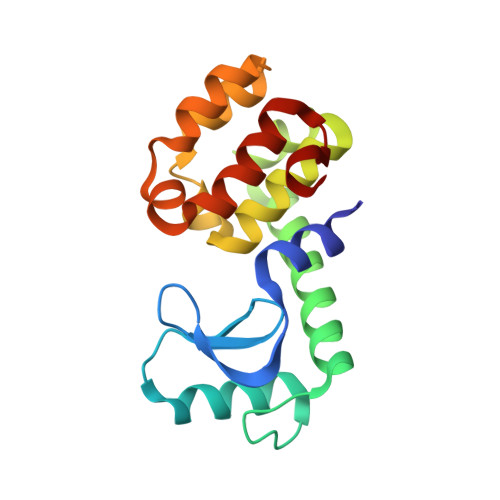A Model Binding Site for Testing Scoring Functions in Molecular Docking
Wei, B.Q., Baase, W.A., Weaver, L.H., Matthews, B.W., Shoichet, B.K.(2002) J Mol Biol 322: 339-355
- PubMed: 12217695
- DOI: https://doi.org/10.1016/s0022-2836(02)00777-5
- Primary Citation of Related Structures:
1LGU, 1LGW, 1LGX, 1LI2, 1LI3, 1LI6 - PubMed Abstract:
Prediction of interaction energies between ligands and their receptors remains a major challenge for structure-based inhibitor discovery. Much effort has been devoted to developing scoring schemes that can successfully rank the affinities of a diverse set of possible ligands to a binding site for which the structure is known. To test these scoring functions, well-characterized experimental systems can be very useful. Here, mutation-created binding sites in T4 lysozyme were used to investigate how the quality of atomic charges and solvation energies affects molecular docking. Atomic charges and solvation energies were calculated for 172,118 molecules in the Available Chemicals Directory using a semi-empirical quantum mechanical approach by the program AMSOL. The database was first screened against the apolar cavity site created by the mutation Leu99Ala (L99A). Compared to the electronegativity-based charges that are widely used, the new charges and desolvation energies improved ranking of known apolar ligands, and better distinguished them from more polar isosteres that are not observed to bind. To investigate whether the new charges had predictive value, the non-polar residue Met102, which forms part of the binding site, was changed to the polar residue glutamine. The structure of the resulting Leu99Ala and Met102Gln double mutant of T4 lysozyme (L99A/M102Q) was determined and the docking calculation was repeated for the new site. Seven representative polar molecules that preferentially docked to the polar versus the apolar binding site were tested experimentally. All seven bind to the polar cavity (L99A/M102Q) but do not detectably bind to the apolar cavity (L99A). Five ligand-bound structures of L99A/M102Q were determined by X-ray crystallography. Docking predictions corresponded to the crystallographic results to within 0.4A RMSD. Improved treatment of partial atomic charges and desolvation energies in database docking appears feasible and leads to better distinction of true ligands. Simple model binding sites, such as L99A and its more polar variants, may find broad use in the development and testing of docking algorithms.
Organizational Affiliation:
Department of Molecular Pharmacology and Biological Chemistry, Northwestern University School of Medicine, Chicago, IL 60611-3008, USA.

















